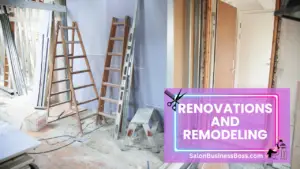Opening a salon can be an exciting and rewarding venture for those passionate about beauty and hair care. However, like any business, starting a salon requires careful planning and financial considerations.
It costs around $15,000 to start a salon, covering essentials like equipment, supplies, and licensing. However, as the business grows, expenses can exceed $100,000 with staff salaries, marketing, renovations, and more.
1. Location and Lease Expenses:
Securing the right location is a critical initial step in starting a salon. The cost of leasing or renting a space can have a significant impact on the overall budget and success of the business. Several factors influence the expense, such as the size of the space, its location, and the demand for salon services in the area.
In a budget-conscious approach, entrepreneurs might opt for a smaller space in a less busy area. While this could lead to lower monthly rental costs, ranging from $1,500 to $3,000, it may also mean potentially lower foot traffic and visibility. However, this approach might be suitable for those looking to test the market or who offer niche services that can thrive in specific neighborhoods.
On the other hand, prime locations in high-traffic areas are often the top choice for salon businesses seeking maximum exposure and a steady stream of potential customers. These sought-after spots, however, come with higher price tags, with monthly rents soaring upwards of $5,000 or more. While the increased costs can be a challenge, the potential for greater customer influx and brand recognition may justify the investment for many entrepreneurs.
The decision on location and rental costs should align with the salon’s business plan, target market, and long-term goals. It’s crucial to strike a balance between affordability and the potential for profitability, ensuring the salon attracts a steady flow of clientele and thrives in its chosen community. Careful consideration of these factors will help lay a solid foundation for a successful salon venture.
2. Salon Equipment and Furnishings:
Equipping a salon with the right tools and furniture is a pivotal step in establishing a successful business. Basic salon equipment comprises essentials like styling chairs, hairdryers, wash basins, and mirrors, and these play a fundamental role in delivering top-notch services to customers. The cost of acquiring this foundational equipment typically falls within the range of $5,000 to $10,000, depending on the brand, quality, and quantity required.
While basic equipment is essential for functionality, investing in high-quality salon furniture is equally crucial for creating an inviting and comfortable ambiance that enhances the overall customer experience. Premium furniture, including reception desks, styling stations, waiting area seating, and decorative elements, contributes significantly to the salon’s aesthetic appeal. The price range for high-quality salon furniture may span from $2,000 to $5,000, and this investment is well worth it to leave a lasting impression on customers and encourage repeat business.
It’s essential for salon owners to strike a balance between the initial investment in equipment and furniture and the salon’s overall budget. Careful consideration of the quality, durability, and aesthetic value of the items will ensure that they align with the salon’s brand identity and target clientele. Additionally, seeking out reputable suppliers and exploring financing options can help manage costs effectively.
By making thoughtful decisions regarding the selection of equipment and furniture, salon owners can create a welcoming environment that not only attracts customers but also establishes the salon as a reliable and professional beauty destination. A well-equipped salon with top-notch furnishings lays a solid foundation for success and paves the way for long-term growth and customer satisfaction.
3. Salon Supplies and Inventory:
Stocking up on essential salon supplies is a crucial aspect of ensuring a seamless and quality service to clients. The inventory typically includes shampoos, conditioners, hair colors, styling products, and other consumables necessary for daily operations. The initial inventory cost will depend on the size of the salon and the range of services offered. With a budget of $15,000, salon owners might begin with a modest inventory to cover the basics.
Careful inventory management is essential to avoid excessive stockpiling of products that might go unused, tying up valuable capital. As the salon gains momentum and customer demand increases, salon owners may reinvest profits into expanding the inventory to accommodate more diverse services and cater to a broader clientele.
Regularly reviewing and replenishing inventory levels will help strike a balance between meeting customer needs and managing costs. Establishing relationships with reputable suppliers and exploring bulk purchase discounts can be beneficial in optimizing expenses and maximizing profit margins.
4. Licensing and Legal Fees:

Before launching a salon, obtaining the necessary licenses and permits is a legal requirement that ensures compliance with local regulations and industry standards. The specific licenses and permits needed can vary depending on the salon’s location and the services offered. Common licenses include a business license, cosmetology license for staff, and health department permits for maintaining a sanitary environment.
The costs associated with licensing and legal requirements can range from a few hundred to a few thousand dollars. It’s essential to research the specific regulations applicable to the salon’s location and set aside an appropriate budget for these expenses.
To navigate the legal intricacies successfully, consulting with a legal professional experienced in the salon industry is advisable. While this incurs additional fees, it provides peace of mind, ensures compliance, and mitigates the risk of facing penalties or legal issues in the future.
Read more about: 5 Differences Between a Barbershop and a Salon
5. Salon Staff and Training:
Hiring salon staff is a pivotal decision that impacts the quality of services and the overall customer experience. In the initial stages, when working with a budget of around $15,000, salon owners might opt for a smaller team or handle operations themselves. Running a smaller team allows for more focused training and close-knit collaboration.
As the salon gains momentum and expands its services, the need for additional staff may arise. When hiring employees, it’s essential to factor in not only their salaries but also the costs of training and benefits. Training ensures that employees are equipped with the necessary skills and knowledge to deliver exceptional services, which ultimately contributes to customer satisfaction and loyalty.
To manage the financial impact of hiring and training, salon owners can consider offering competitive compensation packages while exploring cost-effective training programs and workshops. Additionally, fostering a positive work environment and providing incentives can contribute to employee retention, reducing the need for frequent hiring and retraining.
6. Marketing and Advertising:
Effective marketing and advertising are indispensable for attracting a steady stream of customers to the salon. Allocating a budget for marketing efforts is crucial, even with a modest starting budget of $15,000. Depending on the target audience and the salon’s unique selling points, various marketing strategies may be employed, such as social media advertising, local promotions, and distributing flyers in the neighborhood.
Digital marketing, including creating a professional website and engaging in social media platforms, can be a cost-effective way to reach a wider audience and build brand recognition. Budget-friendly marketing initiatives can be supplemented with word-of-mouth referrals, which are often generated through excellent customer service and positive experiences.
As the salon business grows, it’s essential to continuously assess the effectiveness of marketing strategies and invest in those that yield the best results. Tracking return on investment (ROI) and customer acquisition metrics will help salon owners make data-driven decisions and optimize their marketing budget.
7. Salon Software and Technology:
Investing in salon management software is a smart move that can significantly enhance the efficiency of daily operations. Basic software packages are often affordable and can handle essential tasks like appointment scheduling, customer data management, and inventory tracking. These solutions help streamline workflows, improve customer experience, and ensure that salon staff can focus on providing top-notch services.
As the salon expands, more comprehensive and feature-rich software options may become relevant. These advanced systems might include additional capabilities such as marketing automation, loyalty program management, and financial reporting. While these robust solutions can cost several thousand dollars, the long-term benefits in terms of time and cost savings, improved customer engagement, and business growth justify the investment.
Choosing the right software is essential, as it will become an integral part of day-to-day operations. Salon owners should consider factors such as user-friendliness, scalability, and customer support when evaluating software options.
8. Salon Decor and Ambiance:
The ambiance of a salon plays a crucial role in creating a positive and memorable experience for customers. Creating a comfortable and inviting atmosphere is key to customer satisfaction and retention. Decorative elements like lighting, artwork, and interior design contribute to the overall ambiance of the salon.
With a budget of $15,000, salon owners should prioritize essential decor elements that have the most significant impact on the customer experience. Thoughtful lighting choices can create a warm and welcoming environment, while carefully curated artwork can add a touch of sophistication to the space.
As the business grows and generates revenue, salon owners can consider investing in additional decor upgrades to elevate the overall ambiance. Upgrades might include high-quality furnishings, premium flooring, and more elaborate decor elements that align with the salon’s brand and style.
9. Insurance and Security:
Securing adequate insurance coverage is vital for protecting the salon from potential risks and liabilities. Insurance costs can vary based on the coverage options selected and the size of the salon. Typical insurance coverage includes liability insurance, which protects against claims related to accidents or injuries that occur on the premises, and property insurance, which covers damage to salon property due to unforeseen events like fire or theft.
The annual insurance premiums can range from a few hundred to a few thousand dollars, depending on the level of coverage and the insurance provider.
Additionally, investing in security measures is crucial for safeguarding the salon’s assets and ensuring the safety of staff and customers. Security measures may include surveillance cameras, alarm systems, and access control mechanisms. These investments help deter potential theft or vandalism, providing peace of mind for salon owners.
10. Renovations and Remodeling:

Leasing an existing space might require renovations or remodeling to customize the salon to specific requirements and brand aesthetics. The costs of renovations can vary significantly based on the extent of changes needed, such as building walls, installing plumbing fixtures, or updating the interior design.
For a budget-conscious approach, salon owners might prioritize essential renovations initially and allocate additional funds for more extensive remodeling as the business grows. It’s essential to balance the costs of renovations with the potential return on investment in terms of improved functionality and customer experience.
Hiring experienced contractors and obtaining multiple quotes can help salon owners make informed decisions about renovation expenses while adhering to the available budget. Successful renovations and remodeling can transform the space into a visually appealing and functional salon that leaves a lasting impression on customers.
Read more about: How To Start A Salon For Hair Extensions
Conclusion
Starting a salon with a budget of around $15,000 is possible, but it will require careful planning, prioritization, and creativity. As the business expands and succeeds, you’ll likely need to reinvest profits to meet growing demands, ultimately leading to a total investment upwards of over $100,000. Remember that each salon’s costs can differ based on various factors, so conducting thorough research and seeking professional advice are crucial to making informed financial decisions for your salon venture.
Frequently Asked Questions

1. Are there any ongoing expenses to consider?
Yes, once the salon is operational, you’ll need to factor in ongoing expenses like staff salaries, inventory restocking, utilities, maintenance, and marketing.
2. How much does salon equipment cost?
Salon equipment costs can vary depending on the type and quality of items. Basic equipment might range from $5,000 to $10,000.
3. What licenses and permits are required?
The required licenses and permits can vary by location, but common ones include a business license, cosmetology license, and health department permits.
To learn more on how to start you own salon checkout my startup documents here.
Please note that the contents of this blog are for informational and entertainment purposes only and should not be construed as legal advice. Any action taken based on the information provided in this blog is solely at your own risk. Additionally, all images used in this blog are generated under the CC0 license of Creative Commons, which means they are free to use for any purpose without attribution.

About the author. Entrepreneur and Salon Business Fan.
Hi! I am Shawn and I am a happy individual who happens to be an entrepreneur. I have owned several types of businesses in my life from a coffee shop to an import and export business to an online review business plus a few more and now I create online salon business resources for those interested in starting new ventures. It’s demanding work but I love it. I do it for those passionate about their business and their goals. That’s why when I meet a salon business owner, I see myself. I know how hard the struggle is to retain clients, find good employees and keep the business growing all while trying to stay competitive.
That’s why I created Salon Business Boss: I want to help salon business owners like you build a thriving business that brings you endless joy and supports your ideal lifestyle.

